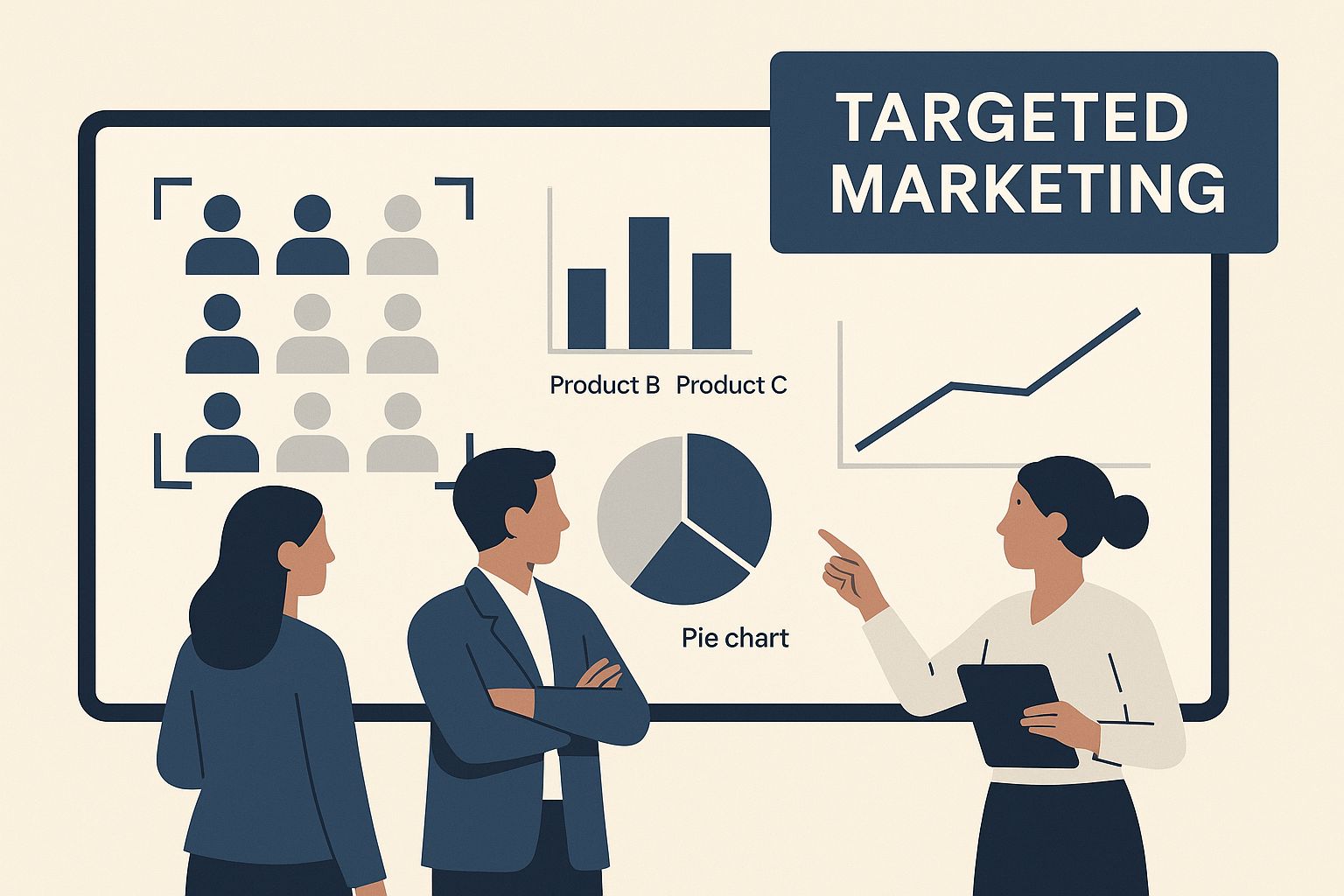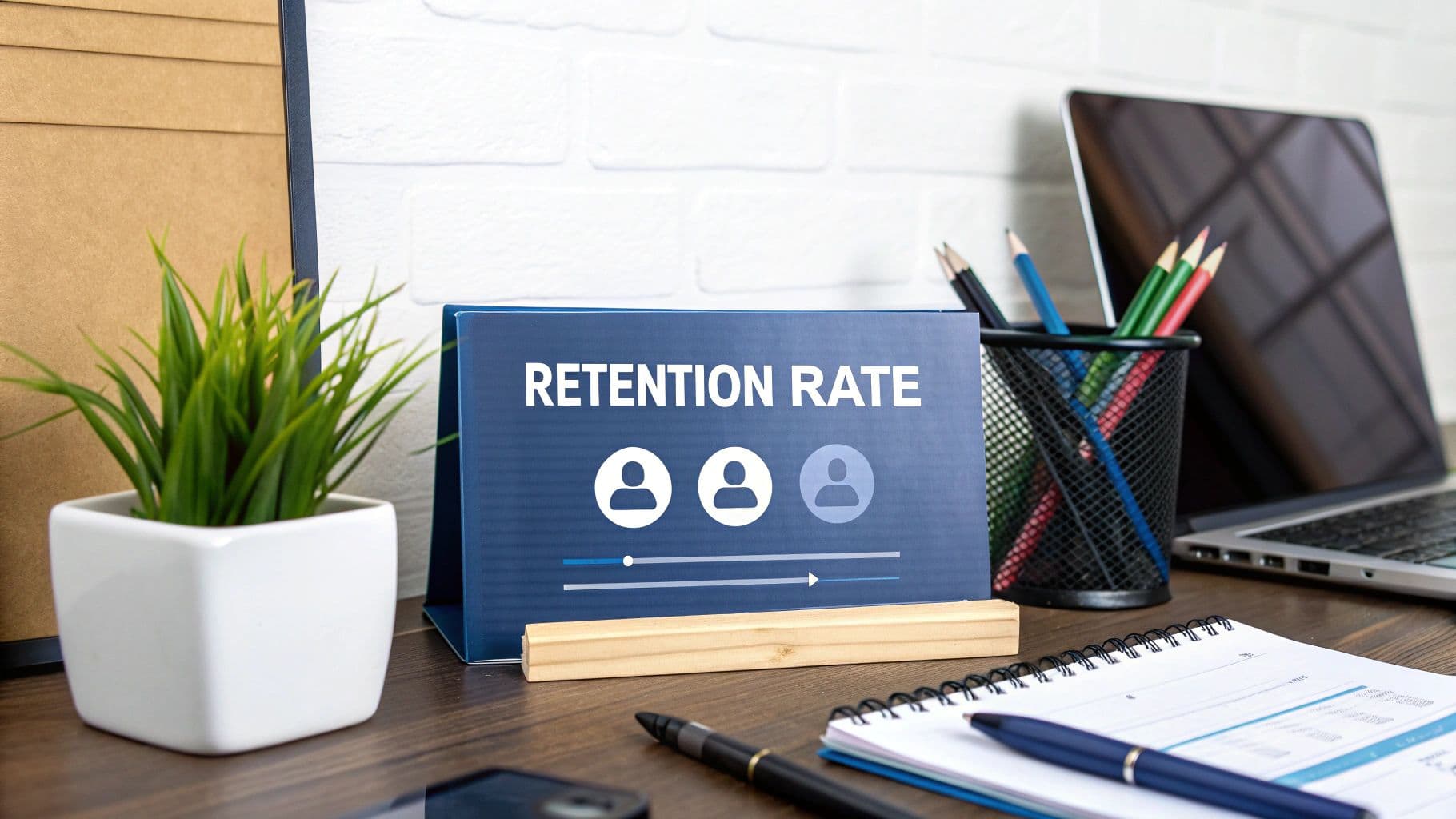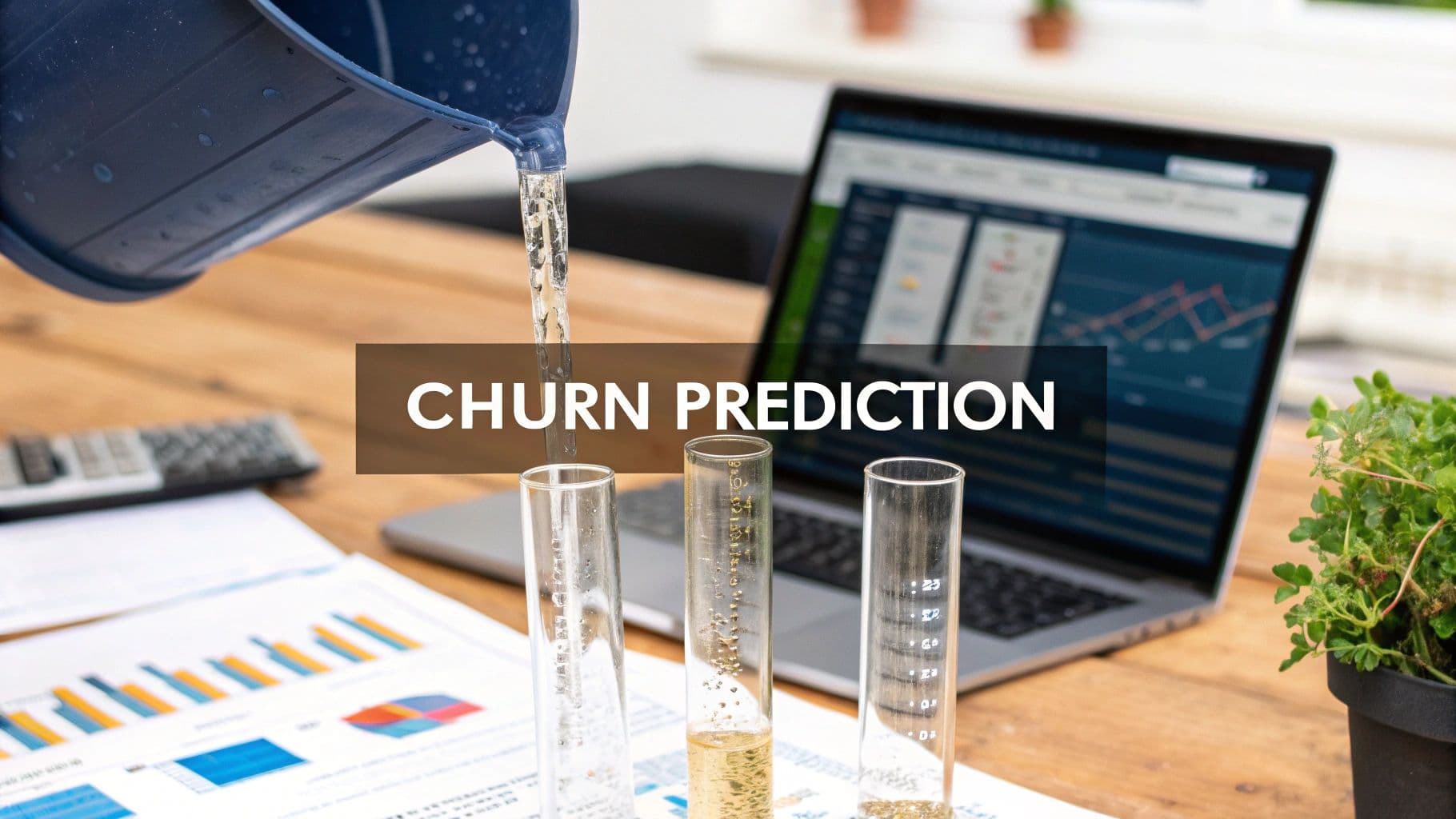Mastering Customer Analysis Segmentation
Unlock growth with our guide to customer analysis segmentation. Learn to build powerful segments, personalize marketing, and drive real business results.

Customer analysis segmentation is really just a structured way of getting to know your audience. Instead of seeing a giant, faceless crowd, you start to recognize smaller, distinct groups of people who share common characteristics. It's the difference between shouting a single message into a stadium and having a meaningful conversation with a handful of people who actually want to listen.
This approach moves your marketing from a generic, one-size-fits-all model to something far more personal and effective. You’re no longer talking at your market; you’re talking with specific segments of it.
Why Generic Marketing No Longer Works
Think about it. Trying to have a single conversation with thousands of people at once—each with different needs, interests, and pain points—is a recipe for failure. That’s exactly what old-school, mass marketing does. It's a shot in the dark, hoping your message randomly hits the right person. Unsurprisingly, this leads to wasted ad spend, dismal engagement rates, and customers who feel completely misunderstood.
This is where customer analysis segmentation completely changes the game. It allows you to stop shouting and start connecting. You can pull smaller, more relevant groups aside for conversations that actually resonate, turning a costly guessing game into a precise, value-driven strategy.
Shifting from Guesswork to Precision
Once you start dividing your audience into clear segments, you can tackle specific business challenges head-on. For instance, you can pinpoint customers who seem to be drifting away and launch a targeted re-engagement campaign just for them. On the flip side, you can identify your most loyal fans and reward them with exclusive perks, turning happy customers into passionate brand advocates.
This infographic is a great visual for how a marketing team might break down its audience to create more targeted campaigns.

It perfectly illustrates the power of moving away from broad assumptions and toward data-backed audience groups that you can actually understand and serve.
The Financial Impact of Smart Segmentation
These benefits aren't just feel-good theories; they hit the bottom line. Hard. When you truly understand what makes different customer groups tick, you can build stronger relationships and deliver experiences that feel like they were made just for them. This focus on relevance is what separates thriving businesses from the ones that get left behind.
The numbers back this up loud and clear. A massive 81% of consumers say they're more likely to buy from brands that offer personalized experiences. Companies that nail their segmentation strategy have seen up to a 760% jump in email marketing revenue. Even more telling, a reported 77% of marketing ROI comes directly from segmented, targeted, and triggered campaigns.
The takeaway is simple: by speaking directly to well-defined groups, businesses see dramatically better results. You can find more insights about segmentation's impact on marketing over on Britopian.com.
The Four Pillars of Customer Segmentation

Great customer analysis segmentation isn’t a guessing game. It’s a thoughtful process built on four foundational frameworks, or what I like to call pillars. Each one gives you a different lens to look through, answering a core question about who your customers are and what makes them tick.
Think of it like getting to know someone. One pillar tells you who they are on paper. Another tells you where they live. The third reveals why they make certain decisions, and the last one shows you what they actually do. You only get the full picture when you bring all these views together.
Let's dig into each one.
H3: Demographic Segmentation: The Who
Demographics are usually the first stop on the segmentation journey, and for good reason—they're straightforward. This pillar groups customers based on objective, factual information. It’s the "who" of your audience, defined by tangible traits.
You’re likely already familiar with the common data points here:
- Age
- Gender
- Income Level
- Education
- Occupation
- Marital Status
For instance, a luxury automaker probably has its sights set on people aged 45-65 with an annual income topping $200,000. This kind of data is relatively easy to find, but it only scratches the surface. It gives you a great starting point, but it won’t tell you a thing about a customer’s motivations.
H3: Geographic Segmentation: The Where
Just like it sounds, geographic segmentation organizes customers by their physical location. This "where" can be as wide as a continent or as specific as a single zip code. It works because where people live often has a massive influence on their needs and buying habits.
A few key geographic variables include:
- Country or Continent
- Region or State
- City or Neighborhood
- Climate (think tropical vs. arctic)
- Population Density (urban, suburban, or rural)
A company selling snowboards isn't going to waste its marketing budget on people in Miami. That's an obvious one. But it gets more nuanced—a restaurant chain might tweak its menu to appeal to local tastes in different countries. This pillar is all about making your message relevant to someone’s immediate environment.
H3: Psychographic Segmentation: The Why
This is where things get really interesting. Psychographics move beyond the "who" and "where" to explore the all-important "why." This pillar groups people based on their inner world—their personalities, values, interests, and lifestyles.
Imagine an adventure travel company. With psychographics, they can create totally different campaigns for two people in the same demographic bracket:
- The Adrenaline Junkie: Their ads will be full of mountain climbing, whitewater rafting, and skydiving.
- The Relaxation Seeker: Their marketing will highlight serene beaches, spa treatments, and quiet forest retreats.
Same age, same income, but completely different motivations. You typically gather this kind of insight from surveys, customer interviews, and by analyzing social media activity.
H3: Behavioral Segmentation: The What They Do
While psychographics uncover motivations, behavioral segmentation is all about action. This pillar groups customers based on what they do—how they actually interact with your company, your products, and your website. For any digital business, this is arguably the most powerful pillar of all.
Behavioral data shows you clear patterns in:
- Purchase History: What they buy, when they buy it, and how often.
- Website Activity: Which pages they linger on or which articles they read.
- Feature Usage: The specific features in your software they use constantly.
- Brand Loyalty: How often they engage, refer others, or open your emails.
A fitness app, for example, can use this data to create incredibly relevant experiences. It might spot a group of users who attend yoga classes 3+ times per week and also use the meditation feature every single day. The app could label this segment the "Mindfulness Mavens" and send them targeted content about a new yoga retreat or a guide to advanced meditation.
This is the key to boosting retention and growing customer lifetime value. In fact, understanding these patterns is essential if you want to accurately calculating customer lifetime value for SaaS and other subscription-based businesses.
H3: Comparing the Four Pillars of Customer Segmentation
To tie this all together, the table below breaks down how these four models stack up against each other. It shows the main question each one answers, the data you'll need, and a simple example of how it works in the real world.
| Segmentation Model | Core Question Answered | Common Data Points | Example Application |
|---|---|---|---|
| Demographic | Who are my customers? | Age, income, gender, occupation, education | A financial services firm targeting millennials aged 25-35 with messaging about first-time investing. |
| Geographic | Where are my customers? | Country, city, climate, population density | A clothing retailer promoting lightweight jackets in warm climates and heavy coats in cold climates. |
| Psychographic | Why do my customers buy? | Lifestyle, values, interests, personality traits | An organic food brand appealing to health-conscious consumers who value sustainability and wellness. |
| Behavioral | What actions do my customers take? | Purchase history, website clicks, feature usage, loyalty | An e-commerce site sending a special discount to customers who have abandoned their shopping carts. |
Each pillar provides a unique perspective, but the real magic happens when you start combining them. That's how you move from a blurry sketch of your audience to a crystal-clear portrait.
Your Step-By-Step Segmentation Blueprint
https://www.youtube.com/embed/rOfg-nbkk8A
Moving from theory to action is where the magic of customer analysis segmentation really happens. Without a solid plan, it’s easy to get lost in a sea of data or build segments that don't actually help your business. This five-step blueprint is your roadmap for turning customer insights into real, measurable results.
Think of it like building a custom piece of furniture. You wouldn't just start cutting wood randomly; you'd have a clear plan and know exactly what you want to build. Segmentation is no different.
Step 1: Set Clear Business Objectives
Before you even glance at a spreadsheet, you have to answer the most important question: What are we actually trying to achieve here? Without a clear goal, your segmentation project is just an academic exercise.
The point isn't just to make groups for the sake of it. You're trying to solve a real business problem. Are you hoping to:
- Slash customer churn? Then your goal is to spot the warning signs and identify at-risk customers before they walk away.
- Boost customer lifetime value (CLV)? You’ll want to find your high-potential customers and figure out how to offer them more value.
- Improve new user activation? The objective here would be to personalize the onboarding flow for different types of new users.
Nailing this first step ensures your segments are not just interesting, but truly useful.
Step 2: Gather and Unify Your Data
Okay, with your objective locked in, it's time to gather your raw materials. Your customer data is likely scattered all over the place—in your CRM, analytics tools, help desk software, and payment systems. The goal is to pull it all into one place for a complete picture.
This is often the trickiest part of the whole process. A huge pitfall here is trying to work with "dirty data"—information that's incomplete, wrong, or just plain inconsistent. Bad data in means bad segments out, which can lead you down a completely wrong path.
Make sure your data sources are clean and reliable. You'll want to pull in a mix of the data types we talked about earlier:
- Demographic: Age, location, job title.
- Behavioral: Last login, features used, purchase history.
- Psychographic: Survey answers, interview notes, user feedback.
Step 3: Choose the Right Segmentation Models
Now you get to pick the framework that makes the most sense for your goal. This is where your objective from Step 1 directly shapes your approach. The model you choose is the lens through which you'll view your customers.
For instance, if your goal is to reduce churn, a behavioral model that zeroes in on product usage and engagement is a perfect fit. You'd be looking for patterns like a drop in how often someone logs in or stops using a key feature.
But if you’re trying to get a deeper understanding of why customers do what they do, a psychographic model is your best bet. A great way to do this is by using the Jobs to be Done template to structure your customer interviews and surveys. It helps you uncover the real motivations behind their actions.
Step 4: Build and Profile Your Segments
This is where you roll up your sleeves and do the analysis. Using your chosen model and the clean data you’ve gathered, you can start grouping customers into distinct segments. This might involve using analytics software, a customer data platform (CDP), or even some fancy spreadsheet work.
Let's say an e-commerce store runs an RFM (Recency, Frequency, Monetary) analysis. They might end up with segments like:
- Champions: These are the rockstars who bought recently, buy often, and spend the most.
- At-Risk Customers: They used to be good customers but haven't bought anything in a while.
- Newbies: Just made their first purchase.
Once you have your groups, give each one a memorable name and build out a detailed profile. This profile should paint a clear picture, telling a story about who these people are, what they do, and what they need.
Step 5: Activate and Measure Your Segments
A segmentation strategy is worthless if it just sits in a slide deck. The final, and most important, step is to put your segments to work by tailoring your marketing, sales, and product experiences for each one.
For your "At-Risk Customers," you could launch a targeted re-engagement email campaign with a special offer to win them back. For your "Champions," you might create an exclusive VIP program to reward their loyalty. This is how you connect data-driven insights to real-world actions.
And don't forget to track your results. You need to measure how your actions are affecting the business goal you set back in Step 1. Did that re-engagement campaign actually lower churn for the at-risk group? Did the VIP program get your champions to spend even more? This constant loop of action, measurement, and refinement is what turns segmentation into a powerful engine for growth.
How AI Is Redefining Customer Segments

The days of treating customer segments like dusty, unchanging lists are numbered. For a long time, segmentation felt like taking a single snapshot of your audience—a useful picture, sure, but one that’s frozen in time.
Now, Artificial Intelligence (AI) and machine learning are fundamentally changing the game. They’re turning that static snapshot into a dynamic, real-time video that can even predict what customers will do next. Instead of just grouping people by past actions, AI builds segments based on future possibilities.
This move from reactive to proactive is what makes modern customer analysis segmentation so incredibly potent. It’s no longer just about who your customers are, but who they could become.
This whole evolution is being pushed forward by a massive shift in what customers expect. People want deeply personal experiences, which makes painting with broad demographic brushes feel completely outdated. One startup founder learned this the hard way after a $50,000 investment targeting "millennials in tech" flopped, a stark reminder of what can happen with oversimplified groups. You can read more about why data is defining personas in 2025 on marketingcourse.org.
Moving Beyond Static Lists with Predictive Segmentation
One of the biggest leaps forward AI brings to the table is predictive segmentation. This is where sophisticated algorithms dive into huge datasets to forecast future customer behavior, and they do it with surprising accuracy. Think of it as a powerful early-warning system for your business.
Instead of waiting for a customer to stop logging in or cancel their subscription, predictive models can spot tiny behavioral shifts that signal they're at risk of churning—long before it actually happens. This gives you a crucial window to step in with a targeted retention campaign when it truly matters.
Here’s what that looks like in practice:
- Spotting High-Value Prospects: AI can dissect the traits of your very best customers, then go find lookalike prospects who are most likely to convert and stick around.
- Predicting Churn Risk: The system can flag accounts that show a drop in product usage, fewer support tickets, or other quiet signs of disengagement.
- Forecasting Future Purchases: By analyzing past buying cycles, AI can predict when a customer segment is about ready to buy again and trigger a perfectly timed marketing nudge.
Predictive analytics turns customer data into a crystal ball. It allows you to anticipate customer needs and address potential issues before they even surface, creating a more seamless and proactive customer experience.
When you know what your customers are likely to do next, you can shape your strategies with much greater precision. To get a feel for the technology behind this, you might check out some of the best predictive analytics software available that makes these capabilities possible.
The Rise of Dynamic Segments and Zero-Party Data
AI also makes dynamic segments a reality. These are fluid groups that customers move in and out of based on their real-time actions and behaviors. A customer who was in your "New User" segment last week could jump into the "Power User" segment this week after mastering a key feature. This constant adaptation keeps your marketing relevant to where each customer is right now.
This dynamic approach gets a major boost from the growing importance of zero-party data. This is the gold standard of customer information—data that people willingly and proactively share with you.
Think of things like:
- Preferences they select in a welcome survey.
- Goals they share during the onboarding process.
- Answers from quizzes or interactive tools on your website.
Unlike shady third-party data, zero-party data is built on trust. Customers hand over this information because they expect a better, more tailored experience in return.
AI algorithms can instantly process this data to place customers into hyper-specific segments from their very first interaction. A user who tells you their goal is to "improve team collaboration" can immediately be funneled into a segment that receives content perfectly aligned with that need. It creates a powerful first impression and gets them to value much faster. This blend of predictive power and customer-given insight is making segmentation more precise and ethical than ever.
Common Segmentation Mistakes and How to Fix Them
Executing a strong customer analysis segmentation strategy is a huge win, but even the best-laid plans can go sideways. I've seen countless businesses invest a ton of time and money into gathering data and building segments, only to watch their efforts fall flat. It’s rarely because the idea was bad; it's almost always due to a few common, avoidable mistakes in the execution.
Knowing these pitfalls ahead of time is your best defense. If you understand where segmentation strategies usually break down, you can steer clear of those errors and make sure your hard work actually moves the needle for your business.
Mistake 1: Over-Segmenting Your Audience
It's so easy to fall into the "analysis paralysis" trap. You've got all this great data, and the temptation is to slice and dice your audience into dozens of tiny, hyper-specific micro-segments. On paper, it looks incredibly precise. In reality, it's a nightmare to manage.
You end up with so many groups that creating a unique message for each becomes completely unrealistic. The whole point of segmenting gets lost.
Instead of creating a laundry list of segments, start with a handful of genuinely high-impact groups. Zero in on segments that are:
- Substantial: Is the group big enough to actually be worth your time and budget?
- Actionable: Are they different enough to need their own unique marketing approach?
- Accessible: Can you actually reach them with your current marketing channels?
A segment is only useful if you can actually do something with it. If you have 20 segments but only have the resources to create campaigns for five, the other 15 are just an academic exercise.
Focus on quality over quantity. It's far better to have three well-defined, actionable segments you can serve well than twenty that just exist on a spreadsheet.
Mistake 2: Relying on Outdated Data
Your customers aren't frozen in time. Their needs, priorities, and life situations are constantly changing. A segment you built on data from six months ago might as well be a historical artifact—it's interesting, but it probably doesn’t reflect who your customers are today.
Using outdated information is one of the fastest ways to create irrelevant messaging and burn through your marketing budget.
To fix this, you have to treat your segments like living things. They need regular check-ups. Set a schedule for refreshing your data and taking a hard look at your segments. If you’re in a fast-moving industry, that might be every quarter. For others, maybe a review every six months is enough. The key is to make sure your customer analysis segmentation is always running on fresh, relevant information.
Mistake 3: Ignoring Why People Buy and What They Do
Demographics are the low-hanging fruit of data collection, which is why so many segmentation projects stop there. But knowing your customer is a 40-year-old male from Chicago tells you almost nothing about why he buys from you. You’re missing the real story—his lifestyle, his values, his motivations. That’s the psychographic layer.
At the same time, ignoring what customers do (their behavioral data) is a massive missed opportunity. How they use your product, how often they log in, and which features they never touch are all powerful clues about what they truly need.
To build segments that actually work, you have to go beyond the "who" and start digging into the "why" and "what."
- Dig into the "why" with customer surveys and interviews to get a feel for their values and day-to-day lives.
- Analyze the "what" by tracking in-app behavior, looking at purchase histories, and measuring engagement.
This richer, multi-dimensional view is what lets you craft messaging that doesn’t just reach your audience but genuinely connects with them.
Real-World Wins: Segmentation Strategies in Action
Knowing the theory behind customer analysis segmentation is great, but the real magic happens when you see it solve actual business problems. These frameworks aren't just for textbooks; they're practical tools for turning data into dollars. When done right, segmentation can slash customer churn, skyrocket engagement, and drive serious revenue growth.
Let's look at a few examples from different industries to see how this plays out on the ground. Each story breaks down a common business headache, the smart segmentation strategy used to fix it, and the impressive results that followed. Think of these as a blueprint for your own success.
How a B2C Retailer Slashed Cart Abandonment
A mid-sized e-commerce store was bleeding money from abandoned carts. It’s a classic online retail problem. Their generic "You left something behind!" emails were getting ignored, and they were watching potential sales vanish every single day.
Instead of yelling into the void, the team got specific. They implemented a behavioral segmentation strategy, looking at who the customer was and what they’d left in their cart. This led them to create three distinct groups:
- High-Value Hesitators: New customers who had loaded up their cart with expensive items but seemed nervous to pull the trigger.
- Loyal Shoppers: Repeat buyers who unexpectedly bailed on a purchase—totally out of character for them.
- Discount Seekers: Shoppers who historically only bought items on sale and had just abandoned a full-price cart.
The generic reminder email was scrapped. Now, each segment got a message that actually made sense for them. The High-Value Hesitators received a reassuring email highlighting the product quality and the store's easy return policy. The Loyal Shoppers got a friendly, low-pressure note asking if they'd run into a technical snag. And the Discount Seekers? They were sent a small, time-sensitive coupon to give them the final nudge they needed.
The impact was almost immediate. The store saw a 22% decrease in its overall cart abandonment rate in just one quarter. Better yet, the personalized messages to the High-Value Hesitators alone clawed back an estimated $50,000 in what would have been lost revenue. It just goes to show that speaking directly to a customer's specific behavior works.
How a B2B Software Company Nailed User Activation
A B2B SaaS company had a different kind of leaky bucket: low user activation. People would sign up for a free trial, poke around for a minute, and then never complete the key onboarding steps. Unsurprisingly, this led to a dismal trial-to-paid conversion rate. Their one-size-fits-all product tour just wasn't cutting it.
Their solution was to combine demographic data (what's your job title?) with behavioral data (what did you click on first?). This customer analysis segmentation approach sorted new trial users into three buckets:
- Technical Users (Developers): Their first stop was always the API.
- Marketing Managers: They wanted to get straight to building dashboards and pulling reports.
- Team Leaders: They were most interested in inviting colleagues and setting up permissions.
With these segments defined, the company built a unique onboarding path for each one. Developers were pointed right to the API documentation. Marketers were guided through creating their first report. Team leaders were prompted to invite their team.
This strategy shifted the focus from teaching users everything the product could do to showing them how to achieve their specific goal as quickly as possible.
This targeted guidance worked wonders. The company saw a 40% increase in users hitting key activation milestones during their trial. That directly led to a 15% improvement in their trial-to-paid conversion rate, adding a hefty chunk of new monthly recurring revenue to their bottom line.
How a Global CPG Brand Won by Thinking Local
A massive consumer packaged goods (CPG) brand was losing ground in several key international markets. The global, cookie-cutter marketing campaigns that had worked for decades were suddenly falling flat. Local audiences were increasingly choosing smaller, regional brands that seemed to "get" them.
This wasn't just a hunch; it reflects a major consumer shift. Global research recently found that 47% of consumers now see locally owned as an important purchasing factor. Why? The top reasons are a desire to support their local economy (36%) and a simple belief that local brands just do a better job of meeting their needs (20%). You can dive deeper into this consumer trend on mckinsey.com.
To fight back, the CPG giant pivoted to a strategy combining geographic and psychographic segmentation. They dug into consumer data country by country, identifying local values, lifestyle trends, and how people preferred to be spoken to. For example, a campaign in Southeast Asia was reworked to feature local family traditions. In Scandinavia, that same product was marketed with a heavy emphasis on sustainability and minimalist design.
By tailoring its message to what mattered locally, the brand completely turned things around. It saw a 10% sales lift in those targeted regions within six months and a huge boost in brand sentiment scores. It was a powerful lesson that even the biggest players have to think small to win.
Ready to turn your customer feedback into revenue-driving insights? SigOS is an AI-driven product intelligence platform that helps you prioritize what to build next by identifying the signal in the noise. Learn more and request a demo at https://sigos.io.
Keep Reading
More insights from our blog


